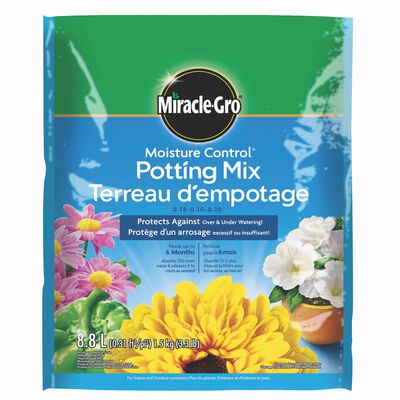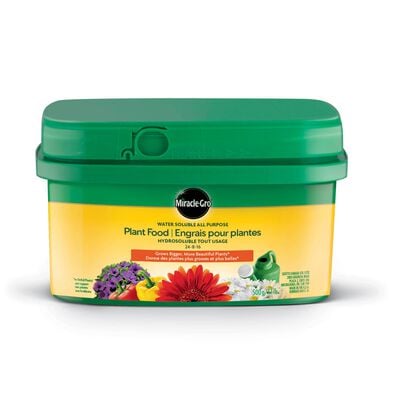
How to Pick the Best Kind of Pot for Your Plant
Garden pots come in all sorts of shapes, materials, and sizes. Some are ideal outdoor pots, while others do better indoors. Probably the trickiest part of container gardening is knowing what size garden pot to use. Our guide below can help.
When growing any type of plant in a container, it's vital to choose the right kind of soil. Filling pots with Miracle-Gro® Moisture Control® Potting Mix helps plants thrive by protecting them against both over- and under-watering. For the very best results from your container garden, though, you'll want to add one more element: regular feedings with Miracle-Gro® Water Soluble All Purpose Plant Food. This will nourish your garden instantly, leading to bigger and more beautiful plants (vs. unfed). To get a jump on harvesting when planting vegetables and herbs, choose young plants instead of starting with seeds.
One more thing to keep in mind: If you plan to reuse last season's potting mix, it will need a little rejuvenation. Soils tend to break down over time, losing most of their nutrients as well as their ability to retain water.
Plant Pot Size Guide
Garden containers can be measured in either inches or gallons. (Inches refer to the pot diameter, or the distance across the top of the container.) Use the guide below to help pick the right size pot for each plant.
Plant a 10-inch (2.5- to 3-gallon) pot with:
- Strawberry (1)
- Leaf lettuce (1)
- Swiss chard (1)
- Bush beans (1)
- French (round) carrots (11 to 12)
- Turnips (4)
- Small herbs, such as Chives, Parsley, Mint, or Sage (1)
- Annuals (1 to 3)
Plant a 14-inch (6- to 7-gallon) pot with:
- Dwarf sweet corn (6 to 7)
- Cabbage (1)
- Collards (1)
- Carrots (9 to 10)
- Edamame (2)
- Peas (4)
- Leaf lettuce, Spinach, or Arugula (3 to 4)
- Larger herbs, such as Rosemary or Lavender (1)
- Annuals (3 to 4)
Plant a 16-inch (9- to 10-gallon) pot with:
- Pole beans on trellis (3 to 4)
- Annuals (4 to 6)
- Dwarf shrub
- Goji berry (1)
- Gooseberry (1)
- Dwarf citrus tree (1)
- Dwarf bush-type fruits, such as Raspberry or Blueberry (1)
Plant an 18-inch (14- to 15-gallon) pot with:
- Broccoli (1)
- Cauliflower (1)
- Eggplant (1)
- Pepper (1)
- Determinate (or bush) tomato and support (1)
- Any kind of green, leafy vegetables (varies; see plant tag or seed packet for spacing guidelines)
- Multiple herbs (varies)
- Multiple annual flowers (varies)
Plant a 24-inch (24- to 25-gallon) pot with:
- Indeterminate (vining) tomato and cage (1)
- Cucumber (1)
- Summer squash (1)
- Annuals in multiples
- Fig tree (1)
- Dwarf peach or nectarine (1)
- Columnar apple (1)
- Pomegranate (1)
- Blackberry or raspberry (1)
- Ornamental shrub, such as hydrangea, shrub rose, or butterfly bush (1)
- Evergreen shrub (1)
Plant a 30-inch (30-gallon) pot with:
- Espalier fruit tree, such as apple, pear, or plum (1)
- Dwarf cherry tree (1)
- Sweet corn (1)
- Pumpkin (1; bush types are best)
- Rhubarb (1)
Pick the Right Type of Pot
The last step in choosing the right garden container is to select the material that best suits your plant and the growing conditions. Pots for plants come in a variety of materials. Choose based on the descriptions below, and make sure the pot has drainage holes.
Terracotta:
A traditional favorite. Small sizes are affordable, but larger and ornate styles can be priceyand often quite heavy to carry. Tends to dry out quickly, which makes it ideal as an indoor pot for drought-loving plants and Mediterranean herbs like rosemary, sage, and thyme. Glazed terracotta doesn't dry out as fast. Freezing temps can crack or weaken terracotta when used outdoors. Best stored empty through winter in cold regions.
Plastic:
Lightweight, durable, and affordable. Bright colors add zing to any setting, or select traditional terracotta tones. With outdoor pots, direct sun heats black plastic, which can harm roots in hot climates. Also consider alternative plastic containers, like tubs, bins or buckets. These work well both indoors and out.
Wood:
Offers a natural look that blends well into garden settings. Wood is durable and weather-resistant, although it does break down over time. Half-barrel wooden containers are quite heavy once filled with soil, so put them in place beforehand. Wooden containers are best for outdoors.
Glazed Ceramic:
Strong and durable, these pots often boast beautiful colors. They can be pricey, though, and don't stand up well to freezing temps. Perfect for indoors.
Concrete:
Tops in durability, though these containers commands a high price. Extremely heavy. Best used outdoors.
Learn more about container gardening by checking out the article below. For more details about Miracle-Gro® Moisture Control® Potting Mix, to purchase the product online, or to find a retailer near you, click on the product link at right.

